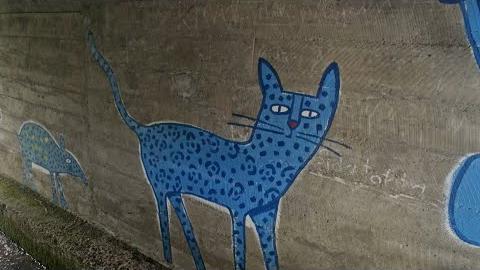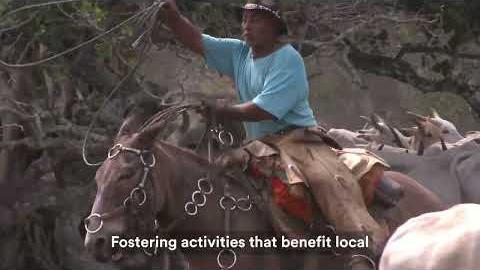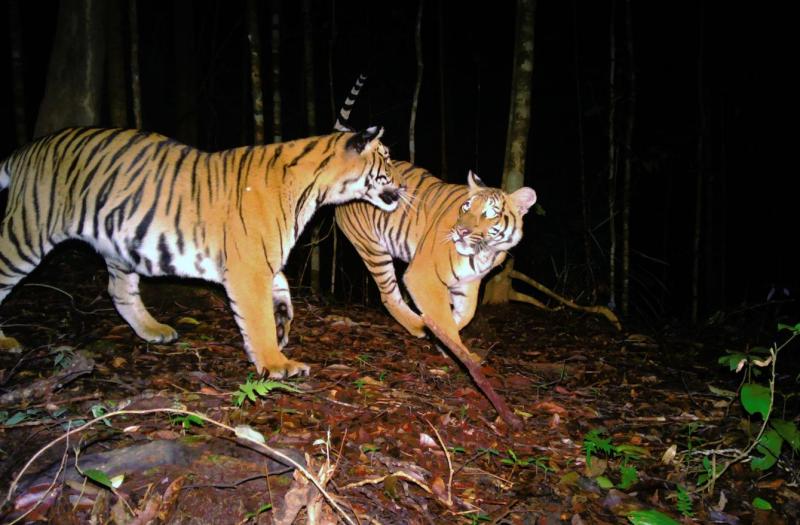About Jaguars
The largest cat in the Western Hemisphere, jaguars (Panthera onca) roam across 18 countries, spanning from Mexico to Argentina. Jaguars have been eradicated from nearly 50 percent of their historic range and are classified as Near Threatened on the IUCN Red List of Threatened Species. Our Jaguar Program includes the bold Jaguar Corridor Initiative to connect core jaguar populations from Mexico to Argentina. Our teams are leading or supporting efforts in almost a dozen jaguar range countries. These efforts have contributed to the formation of a range-wide partnership called the Jaguar 2030 Roadmap, which aims to work with jaguar range States to secure 30 priority jaguar landscapes by 2030.
Our Goals

Work with jaguar range states to secure 30 priority jaguar landscapes by 2030.
Where Do Jaguars Live?
Jaguars occur in 18 countries throughout Latin America, ranging from Mexico to Argentina across a variety of habitat types, including swamps, tropical forests, scrublands, and deserts. Jaguars also thrive in a variety of wet habitat, including flooded forests and the Brazilian Pantanal. Although lone, dispersing male jaguars have been recorded in the southwestern United States, no females and no viable breeding population have been recorded there for nearly 100 years.
Where We Work
Belize: Through Dr. Alan Rabinowitz’s jaguar studies in the 1980s, he helped develop the world’s first jaguar reserve in the Cockscomb Basin Wildlife Sanctuary. Since the early 2000s, our team has continuously monitored the jaguar population in CBWS and beyond, contributing to one of (if not the) longest-term jaguar databases in the world. Our work with local NGOs and government partners helps to provide informed conservation action for jaguars.
Brazil: Brazil has the largest jaguar population in the Americas. In the Brazilian Pantanal, Panthera manages Fazenda Jofre Velho, our jaguar research base. We have developed methods to mitigate human-jaguar conflict by working with communities, farmers and ranchers throughout the Pantanal biome and jaguar range. We also work with ecotourism operators and local education through our Jofre Velho School
Colombia: Home to approximately 22 percent of the world’s remaining jaguars, Colombia is a key player in the Jaguar Corridor, as it is a critical area for genetic connectivity between jaguars in Mesoamerica and South America. Our team works with many ranches and local communities throughout Colombia to mitigate human-jaguar conflict, and through Escuela Jaguar.
Costa Rica: In Costa Rica, we monitor jaguar populations, help prevent wildlife collisions on highways, collect jaguar scat samples for genetic analysis, and mitigate conflict between jaguars and people.
Honduras: Our focus is on strengthening park ranger teams throughout the Jaguar Corridor, on-site security actions, and implementing SMART patrols in key areas. We have also introduced acoustic monitoring, human-cat conflict mitigation with farmers, and rewilding jaguar prey species.
Mexico: We address threats to jaguars in Mexico by helping wildlife law enforcement better counter illegal poaching and supporting community control and protection activities. To date, we have worked within 11 Jaguar Conservation Units (JCUs) and approximately 20 biological corridors.
We also collaborate with partners in Bolivia, Guatemala, Nicaragua, Peru, Paraguay, Argentina, and Suriname.
- Historic Range
- Current Range
FAQs
What do jaguars eat and how do they hunt?
Jaguars use their powerful jaws to pierce the skulls of a diverse array of species, such as capybaras, peccaries, caimans, and reptiles. Throughout their range, jaguar diet includes over 85 different prey species.
How do you tell the difference between a leopard and a jaguar?
While leopards live in Africa and Asia, jaguars are found across the Americas. Jaguars are larger, heavier built, and stockier than leopards. Leopards are covered in smaller solid spots and rosettes, while jaguars are covered in rosettes with distinct internal spots.
Can jaguars purr?
Most big cats, including jaguars, cannot purr. Instead, they’re known for their famous roars. This iconic vocalization is due to the hyoid bone in the cat’s throat being attached to a specialized stretching ligament.
What are the threats facing jaguars?
The species is threatened by habitat loss and fragmentation, conflict with ranchers and/or local communities, and mortality from direct retaliation by people due to the real or perceived threat posed to livestock and overhunting of the jaguar’s prey.
How can we save jaguars and what can I do to help?
Together, we can secure and link jaguar habitat and populations in the Jaguar Corridor. We aim to do this through site security and wild management in critical protected areas and by collaborating with local communities, farmers, and ranchers to reduce conflict and increase human tolerance. Supporting Panthera by sharing our posts on social media or becoming a recurring donor is a great way to help jaguars and other wild cats.






